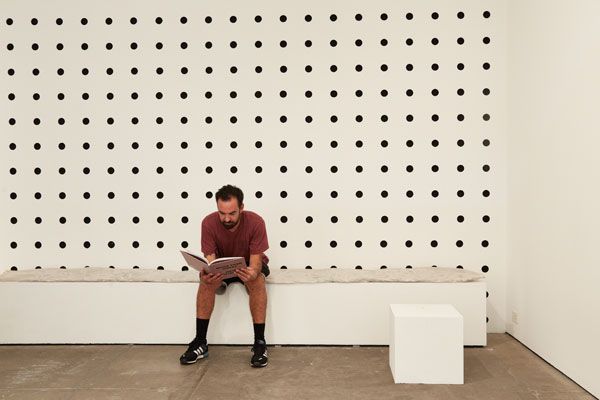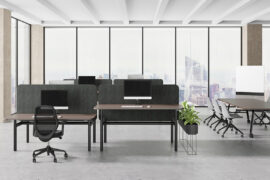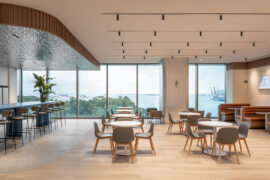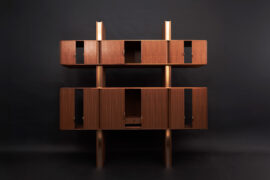Increasingly popular but with potential to be wasteful, Folk Architects are interested in sustainable pop ups. We chat to co-founder of Folk Christie Petsinis about the exciting places pop ups could be headed.

February 20th, 2015
Last weekend – you may have been lucky enough to see – Folk Architects installed a pop up cafe at the Centre for Contemporary Photography in Fitzroy, Melbourne.
CCP say, “As part of the inaugural Photobook Melbourne festival, the pop up cafe had to serve a dual purpose,” says Missy Saleeba, General Manager of the Centre for Contemporary Photography. “We wanted visitors to feel they had a space to really dive into the literature on hand and enjoy a decent coffee while exploring the world of photobooks.”
A collaboration between the Centre for Contemporary Photography, Communications Collective and Folk Architects and part of Photobook Melbourne – a brand new arts festival running until the 22nd of Feb, the pop up space was was constructed entirely from found materials.
With the temporary nature of pop ups, and thus there tendency to be wasteful, there was a strong focus on sustainability. Due to helpful sponsors and reused materials, Folk managed to install the cafe for only $50.
With pop ups of all kinds only increasing in popularity, we chat to Christie Petsinis, co-founder of Folk Architects, about how we might be more sustainable in our design approach.
Indesign Live: Tell us about your stance on pop-ups
Folk: Non-committal installations give us the opportunity to be playful and expressive, less formal.
However, even if the lifespan of a project is intended to be short, the intentions set out at the beginning of the project and basic principles should ensure that it is fit for purpose and adaptive.
‘Pop ups’ are great test pilots to develop new ideas, as in their very nature they can quickly transform a space by adding another layer / finer grain.
Also, they can be useful experiments and tools to see if more permanent structures are required, and how these may best be configured.
IDL: Tell us about the weekend, what was the response to the pop-up space? Did people notice the sustainable features – namely that it was made with found materials?
Folk: While it may not have been immediately obvious that the installation was fabricated from found objects, the configuration and materials applied seemed to evoke a sense of playfulness and intrigue amongst visitors.
The installation consisted of:
1. Bubble Wrap, we had three rolls on hand and folded the material so it could be reused in the future. It was then bound with builders plastic and tape to seal the edges. As the plastic wrap was slightly opaque so it wasn’t immediately obvious what the objects were made from.
2. Pillows placed on top of the seating were made from foam packing tubes, the local butcher kindly gave us a dozen clear plastic bags and we cryovaced and sealed the tubes within the film.
3. The other items were two long cushions on the existing plinths within the gallery. For this we again used the builder’s plastic wrap to create pillows which were filled with shredded paper from the printer next door. This created a subtle texture that was visible with some coloured paper below.
The overall intention was not meant to compete with the art. Therefore, we thought that these seating objects were required to balance being functional, yet subtle and not too distracting.
IDL: You’ve mentioned pop-ups, temporary by nature, are often unsustainably built. When did you first notice this?
Folk: While we do love fashion and events, I studied a post-graduate degree in Urban Culture in Barcelona, with a New York based student who worked in fashion – the infrastructure, materials and wastage that often go into creating sets for fashion week appears incredibly wasteful for a short runway lifespan (5-10mintues)
Spring Racing Carnival and other events that happen locally suffer this as well. There is sometimes a tendency to create a sharp, starch set which is thrown away after the event.
IDL: Was it first-hand experience that made you aware of their environmental downfalls?
Folk: We’ve worked out at Flemington during spring racing carnivals and there are elaborate sets built to last a week or so that are often discarded and not reused.
Similarly in our everyday, we visit sites and see the builder’s offcuts and wastes accumulated through the construction process. In response we are always foraging around to see what we can create from these leftover bits and pieces. We are also aware of the efficiencies of design and being mindful of material sizes and reducing the amount of wastage throughout the design process.
IDL: In a way, pop-up spaces are paradoxical – because they are temporary there is a sense they are low-impact, able to pop-up, fit in anywhere and move on in a moment. At the same time, that fits into a ‘throw away’ culture. Would you agree?
Folk: Yes this can be the case however at the same time temporary space can be designed for flexibility with reuse in mind. For example, Hortus our temporary activation project in the Docklands, has been engineered and designed so that it can be relocated and used as a greenhouse or multipurpose space in another context.
The Docklands area in Melbourne is still new, and we anticipate that this project assists in creating another layer, finer grain to the precinct that can become a catalyst for other interventions within the area – and a test pilot for ideas that can assist to facilitate the best built outcomes for the site in the future.
IDL: How do you see this growing trend in terms of sustainability?
With this space, you’ve gone for found materials as a way to combat the sustainable issues with temporary spaces. What are other ways in which pop-up design could become more sustainable?
Folk: Make the most of what you have on hand, this requires spending time on site, exploring ideas at the beginning of the project that are meaningful and considered.
Design with reuse in mind – think about how the outcome can be useful after the event.
As each project is site specific, contextually appropriate outcomes that fulfill the intended use and brief.
And then it’s about the process – things need to be questioned the entire way through the project and re-evaluated.
We believe that a team of people (clients, makers, etc) require a shared vision and understanding of the design process.
IDL: Are thoughtful pop-ups something we can expect to see more of?
Folk: We hope so! It does take more time and consideration – and you really need to be very hands on – inherently making the most of what you’ve got, determining the sizes of materials so as they can be reused, etc.
Pop-ups don’t have to necessarily contribute to a throwaway culture – consideration and development of meaningful concepts.
We also see pop-ups as exciting undertakings, providing the freedom to explore ideas, connect with community and engage people through the act of finding and making – they can activate underutilised spaces, reveal places in a new light, and facilitate creating a community through this process.
Folk Architects
folkarchitects.com
INDESIGN is on instagram
Follow @indesignlive
A searchable and comprehensive guide for specifying leading products and their suppliers
Keep up to date with the latest and greatest from our industry BFF's!

A curated exhibition in Frederiksstaden captures the spirit of Australian design

The undeniable thread connecting Herman Miller and Knoll’s design legacies across the decades now finds its profound physical embodiment at MillerKnoll’s new Design Yard Archives.

In a competition held by K5 Furniture in collaboration with Monash University, students were challenged with a brief of mycelium-based product design. We visit the avant-garde with the exhibition ‘Metanoia’.
’Tis the season… for Workshopped’s inaugural Christmas markets.
The internet never sleeps! Here's the stuff you might have missed

Krost’s new Ace height-adjustable system challenges convention with the world’s thinnest column profile, engineered for design-led workspaces.

Bean Buro’s Singapore office for Anglo-Eastern is a poetic continuation of their Hong Kong headquarters — a workplace that balances identity and calm.

Adam Markowitz Design, in collaboration with Simeon Dux, has been awarded The Object at the INDE.Awards 2025. Their winning project, A Cabinet of Curiosities, is a masterwork of craftsmanship and adaptability; a poetic response to shifting domestic and professional life in the post-COVID era.